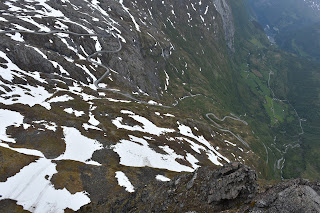Friday, June 23rd
Stavanger, Norway
ms Koningsdam
Voyage of the Midnight Sun
Day 13
Chance of Rain - 58 Degrees
The weather on this trip has been a mixed bag. Mostly marginal, occasionally great, never terrible. We were really hoping for good weather for our boat ride today, but it turned out on the verge of terrible. The fog was so thick this morning, we couldn't see the bow from the forward decks. No scenic cruising. The fog lifted enough to dock the ship, which was no guarantee, but the clouds and drizzle remained through the day. No worries. Rain has never kept us below decks.
We docked in the Vågan harbor, right in the heart of town.
Stavanger is the Dallas of Norway, the "Arabia of the North," home port of the oil business. Oil was discovered in the North Sea off the coast of Norway in 1969, and it has transformed the economy making Norway the richest of the Scandinavian nations. Norway is the third largest exporter of oil in the world at 1.6 million barrels a year, and holds one-half of Western Europe's oil reserves. They know it's a finite resource, the petroleum expected to run out in 30 - 70 years, so they are holding the proceeds in trust for future generations, currently valued at more than $1,000,000 per Norwegian. In spite of their wealth in fossil fuels, Norway is determined not to rely on them. Electric cars, for instance, are subsidized by 50% by the government, and enjoy every privilege on the road imaginable. Stavanger has an outstanding Petroleum Museum. Given the weather today, we probably should have done that instead.

But, we are here to bask in the splendor of Norwegian natural beauty, and the Lysefjord is said to be one of the most beautiful. It is famous for one rock formation in particular, Pulpit Rock, a promontory, more of a diving board really, that juts out over the fjord at a height of 1,959 feet. The true glory goes to those who hike up the mountain for a view from the top, but the view looking up at the people looking down is supposed to be pretty cool too.
We cruised through the Stavanger Archipelago in a catamaran on our way to Pulpit Rock. Perhaps this would be a good time to review our Pet Peeves of Photography:
- Taking pictures through windows.
- Taking pictures through rain-streaked windows.
- Taking pictures with flash through windows.
- Taking pictures of distant subjects with flash.
- Photographers who don't know how to disable their built-in flash.
- Tripods in inappropriate settings.
- Selfies - the word.
- Selfies - the concept.
- Selfie Sticks
- Posing for a picture in front of something that would be way more beautiful without you standing in fucking front of it.
- Adults taking pictures with a camera phone.
- Taking pictures with a tablet.
- Taking pictures with a tablet with the cover of the tablet hanging down below it.
When we got close to the Rock, we scrambled out on deck in the pouring rain to take pictures. With the boat drifting directly underneath, we craned our necks to look straight up into the clouds, rain dripping into our eyes and mouths, and we could just make out the faintest visage of Pulpit Rock. Drying the lens between each frame, we managed to record the image for posterity. In this case, the picture does do it justice, which isn't much.
We also cruised into a little grotto for a pleasant view, the high walls of the cliffs protecting us from the driving rain. And, we got within inches of another great waterfall, but the rain combined with the mist emanating from the avalanche of water, made it better to look at from the inside.
This being Norway, of course, we had to stop for waffles with sour cream and jam. For those keeping track at home, that's three waffle stops on this trip, from a train, a bus, and a boat. It's like a road trip in the American South with a Waffle House on every corner.
Wet and weary, we set sail back toward the ship, and then on the ship for home.
Next Stop: Amsterdam, The Netherlands





























































